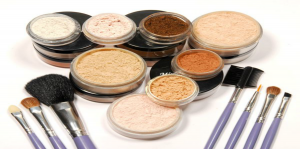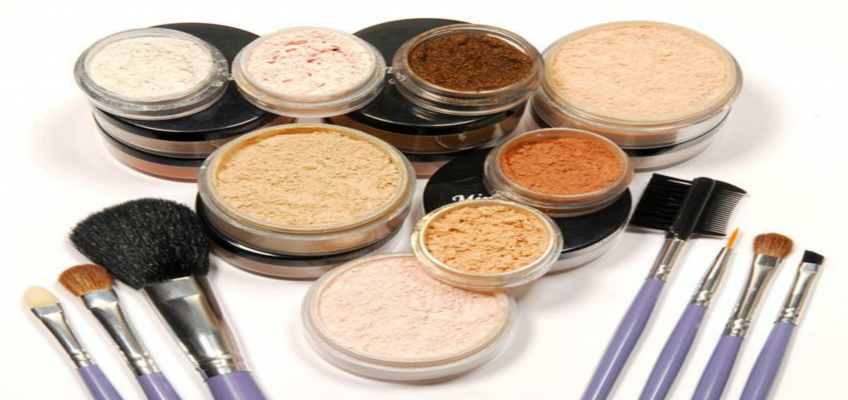Mineral makeup has been a rage in recent years. It appears as the ecological solution proposed by cosmetics manufacturers. So we decided to investigate to find out more about this phenomenon.
Benefits of mineral makeup? OR Is mineral makeup is right for you or not?. This is the subject that we discussed.
Firstly, let us talk about What is mineral makeup?
Mineral makeup consists of ground crushed minerals. It comes in the form of a powder which changes the usual products often compact or liquid such as foundations, blushes or eyeshadows. For more information about safe cosmetics please read our blog Lead in lipstick.
Its formula is more focused on the health of the skin. It promises comfort and a very natural look. It does not clog pores. And protects the skin from the sun and external aggressions from ingredients derived from the earth.
Some examples of minerals that are one of the ingredients in mineral makeup:
Titanium dioxide: protects the sun, reflects light, provides high coverage, is water-resistant and helps in adhering make-up to the skin.
Kaolin: it absorbs sebum and mattifies the skin, soothing, cleansing and anti-inflammatory virtues.
Mica: a basic component of powders, allows different finishes (matt, satin, gloss or glitter).
Iron oxide: color pigment allowing the development of a variety of colors.
Zinc oxide: it soothes irritated skin, anti-inflammatory, soothing, antiseptic, offers high coverage, helps the adherence of make-up on the skin.
Silica: diffuses light, reduces the appearance of wrinkles, absorbs sebum and mattifies the skin.
The mineral makeup is 100% natural, only composed of minerals. Formulated without preservative, it is naturally antimicrobial and without nanoparticles. It nourishes and protects our skin while fulfilling its function of makeup. In the absence of added chemicals or fragrances. It gives a beautiful shine to the skin and rendering “zero defect”.
Mineral makeup is also ideal for the sensitive, reactive and irritated skin. It is suitable for all skin that is allergic to traditional makeup and to mixed, oily or problem skin.It is a non-comedogenic and letting the skin breathe. Mineral makeup is full of minerals with anti-inflammatory and healing properties.
Mineral makeup
Finally, mineral makeup uses abundant resources from the land. And does not draw from the limited resources that are present in traditional cosmetics.
How to choose the mineral make-up brand?.
Mineral makeup brands are not all similar. Some manufacturers also wanted to take advantage of the development of mineral makeup. They do this by directly applying the term “mineral” to their collection as they contained some minerals (often mica, zinc oxide or titanium dioxide). But the real mineral makeup is much more demanding. First, it exists only in powder form.
A lipstick, a gloss or a mascara can not be entirely mineral makeup. It is important to ensure that the list of ingredients contains only minerals, regardless of their number. Indeed, in an environment exclusively composed of minerals, the bacteria do not develop or then very difficult.

However, as soon as non-mineral ingredients come in contact, this naturally present antibacterial protection is broken. On contact with the skin, the brush used to apply the powder can spread the bacteria in the product and on our face. To protect the skin from UVA and UVB, it is important that the powder contains zinc (titanium dioxide).
The more ingredients are at the top of the list, the greater the proportion in the formula. So if zinc is at the end of the list, especially if it’s a foundation, it’s better to switch to another product. Although this may seem a bit paradoxical. It is important to avoid a mineral: bismuth oxychloride.
A point on talc Although manufacturers are using less and less talc in cosmetic products. It is better to check that the product does not contain talc. According to some scientific studies, it would have chemical similarities with asbestos. A particle of talc would remain present for more than 8 years in the body before dissolving. However, the talc used in cosmetics must be non-alkaline and avoids any risk of respiratory toxicity.
It would also be potentially carcinogenic (especially cancer of the uterus and ovary). But when used other than in cosmetics (eg for intimate hygiene). In cosmetics, talc is mostly to neglected because it can dry out the skin and cause irritation. It is mainly used in mineral makeup for its mattifying effect but often as a filling ingredient. But now its place is taken by mica (aluminum silicate), a natural antiseptic. There is no risk of migration of aluminum inside our body.
The key criteria for choosing your mineral makeup:
Make sure that the composition is 100% mineral. To ensure the presence of zinc (sun protection). Avoid products based on bismuth oxychloride and talc (especially for sensitive skin and acne).
In conclusion, Mineral makeup has many benefits if chosen correctly. Hope you like this information. We love to hear from you. For any question please comment below.
Also visit
https:/www.facebook.com/perfumeA2Z/
https:/twitter.com/Perfumea2z Follow us on twitter for more.

Leave a Reply